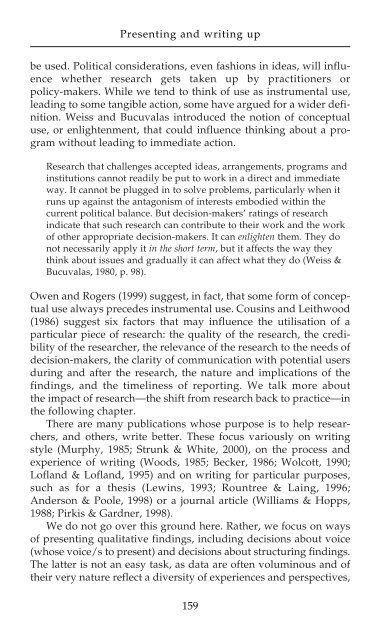Qualitative Research in Practice : Stories From the Field - Blogs Unpad
Qualitative Research in Practice : Stories From the Field - Blogs Unpad
Qualitative Research in Practice : Stories From the Field - Blogs Unpad
You also want an ePaper? Increase the reach of your titles
YUMPU automatically turns print PDFs into web optimized ePapers that Google loves.
Present<strong>in</strong>g and writ<strong>in</strong>g up<br />
be used. Political considerations, even fashions <strong>in</strong> ideas, will <strong>in</strong>fluence<br />
whe<strong>the</strong>r research gets taken up by practitioners or<br />
policy-makers. While we tend to th<strong>in</strong>k of use as <strong>in</strong>strumental use,<br />
lead<strong>in</strong>g to some tangible action, some have argued for a wider def<strong>in</strong>ition.<br />
Weiss and Bucuvalas <strong>in</strong>troduced <strong>the</strong> notion of conceptual<br />
use, or enlightenment, that could <strong>in</strong>fluence th<strong>in</strong>k<strong>in</strong>g about a program<br />
without lead<strong>in</strong>g to immediate action.<br />
<strong>Research</strong> that challenges accepted ideas, arrangements, programs and<br />
<strong>in</strong>stitutions cannot readily be put to work <strong>in</strong> a direct and immediate<br />
way. It cannot be plugged <strong>in</strong> to solve problems, particularly when it<br />
runs up aga<strong>in</strong>st <strong>the</strong> antagonism of <strong>in</strong>terests embodied with<strong>in</strong> <strong>the</strong><br />
current political balance. But decision-makers’ rat<strong>in</strong>gs of research<br />
<strong>in</strong>dicate that such research can contribute to <strong>the</strong>ir work and <strong>the</strong> work<br />
of o<strong>the</strong>r appropriate decision-makers. It can enlighten <strong>the</strong>m. They do<br />
not necessarily apply it <strong>in</strong> <strong>the</strong> short term, but it affects <strong>the</strong> way <strong>the</strong>y<br />
th<strong>in</strong>k about issues and gradually it can affect what <strong>the</strong>y do (Weiss &<br />
Bucuvalas, 1980, p. 98).<br />
Owen and Rogers (1999) suggest, <strong>in</strong> fact, that some form of conceptual<br />
use always precedes <strong>in</strong>strumental use. Cous<strong>in</strong>s and Leithwood<br />
(1986) suggest six factors that may <strong>in</strong>fluence <strong>the</strong> utilisation of a<br />
particular piece of research: <strong>the</strong> quality of <strong>the</strong> research, <strong>the</strong> credibility<br />
of <strong>the</strong> researcher, <strong>the</strong> relevance of <strong>the</strong> research to <strong>the</strong> needs of<br />
decision-makers, <strong>the</strong> clarity of communication with potential users<br />
dur<strong>in</strong>g and after <strong>the</strong> research, <strong>the</strong> nature and implications of <strong>the</strong><br />
f<strong>in</strong>d<strong>in</strong>gs, and <strong>the</strong> timel<strong>in</strong>ess of report<strong>in</strong>g. We talk more about<br />
<strong>the</strong> impact of research—<strong>the</strong> shift from research back to practice—<strong>in</strong><br />
<strong>the</strong> follow<strong>in</strong>g chapter.<br />
There are many publications whose purpose is to help researchers,<br />
and o<strong>the</strong>rs, write better. These focus variously on writ<strong>in</strong>g<br />
style (Murphy, 1985; Strunk & White, 2000), on <strong>the</strong> process and<br />
experience of writ<strong>in</strong>g (Woods, 1985; Becker, 1986; Wolcott, 1990;<br />
Lofland & Lofland, 1995) and on writ<strong>in</strong>g for particular purposes,<br />
such as for a <strong>the</strong>sis (Lew<strong>in</strong>s, 1993; Rountree & La<strong>in</strong>g, 1996;<br />
Anderson & Poole, 1998) or a journal article (Williams & Hopps,<br />
1988; Pirkis & Gardner, 1998).<br />
We do not go over this ground here. Ra<strong>the</strong>r, we focus on ways<br />
of present<strong>in</strong>g qualitative f<strong>in</strong>d<strong>in</strong>gs, <strong>in</strong>clud<strong>in</strong>g decisions about voice<br />
(whose voice/s to present) and decisions about structur<strong>in</strong>g f<strong>in</strong>d<strong>in</strong>gs.<br />
The latter is not an easy task, as data are often volum<strong>in</strong>ous and of<br />
<strong>the</strong>ir very nature reflect a diversity of experiences and perspectives,<br />
159

















